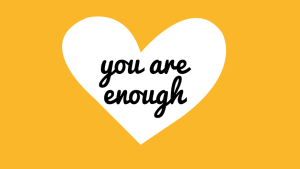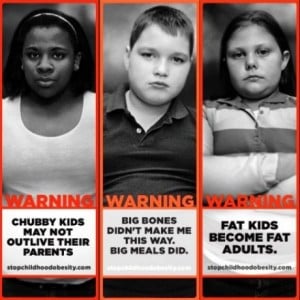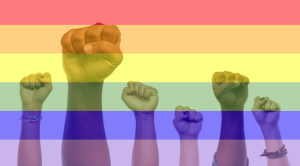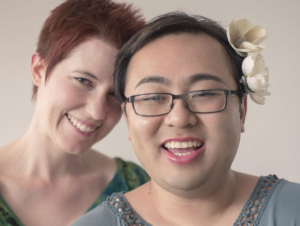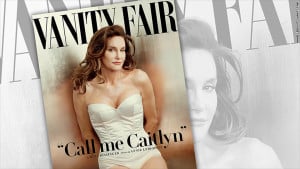
Image: Vanity Fair’s front cover featuring Caitlyn Jenner with the words “Call me Caitlyn”
In the last year, you’ve probably noticed the word transgender enter the vocabulary of folks you never expected: ABC News, Barilla Pasta, Rick Santorum, maybe even your grandma.
On one hand, transvisibility is great! With each trans person that comes out to someone who loves them, the world relaxes its cissexist grip just a smidge.
Slowly, society is learning: Trans people are just like us! Pretty harmless, right?
Well…it depends on who’s saying it. Because when notoriously transphobic folks begin expressing their “acceptance” of trans people, my trans activist radar registers a blip.
A blip that asks: Exactly what are we trying to fit into?
You don’t have to watch Mean Girls to know that fitting in comes at a huge cost. “Fitting in” is a story of assimilation, a loss of individuality, and a loss of resistance to that thing that isolated it to begin with (i.e., the Mean Girls themselves).
As Audre Lorde said, “The master’s tools will never dismantle the master’s house.”
So yes, we’ve made enormous strides in advancing trans visibility, and it’s absolutely worth a moment of celebration. There isn’t a chance Caitlyn Jenner would’ve been on the cover of Vanity Fair years past.
But if the core goal of our trans activism is to dismantle the system of cissexism and it’s symptom, transphobia, we need to steer away from focusing on the acceptance of a few sympathetic stories. Instead, we’ve got to use this time to insist on a reconfiguration of gender in society.
We’ve got to refuse to let our genders be warped into another tool for power and oppression. We’ve got to insist that gender is a vehicle for freedom.
Now that we’re moving into a time of trans visibility, we need to make sure that this is also a time of accountability for our trans activism.
Visibility Is a Double-edged Sword
One of its sharper edges is the quiet engine of normativity.
Normativity is kind of like assimilation. As a marginalized community gains visibility, members who conform to the status quo are granted access to power and privilege. This access is typically reserved for those who most reflect the norm: white, binary gendered, wealthy, thin, able-bodied, English-speaking, US citizens.
I don’t mean to be a total curmudgeon here. Publicly coming out as trans is super brave. And visibility did and does prompt national dialogue in a time where trans lives are targeted daily. I want that.
I want people to open.
But what happens when the doors are only open to a handful of “acceptable” trans lives – those that don’t threaten the status quo? Is that a success?
No. That is transnormativity.
As transnormativity gains steam, it generates what is called respectability politics: I am ok with you being ____________, as long as it fits into the story I have of what an upstanding ________ person looks like.
You’ve likely witnessed gay respectability politics: I’m ok with you being gay as long as you don’t rub it in my face, or I would’ve never known you’re a lesbian, or I’m gay but I’m not like those people.
From gay respectability politics, homonormativity has become part and parcel of our world. Gay people can fit neatly into the (heterosexist) status quo.
But what about those who don’t?
The Belief in a Single Story as the Trans Truth Is Dangerous
In the last month, Caitlyn Jenner has inevitably been mentioned at least once in every workshop I’ve facilitated on gender.
*crickets*
The thing is – Jenner’s gender story certainly doesn’t align with mine. Nor does it align with the gender stories of many of the trans, gender non-conforming, agender, and genderqueer people in my life.
Nor does it align with the stories of those whose lives diverge from Caitlyn Jenner’s by virtue of her overwhelming access to power and privilege through whiteness and through wealth.
Knowing 17 million viewers tuned in to hear Jenner’s story almost felt like a step back.
According to recent research, 92% of Americans don’t know a single (out) trans person. 92%!
For how many Americans was this the first time they heard a trans person discuss their gender at length? For how many Americans has Caitlyn Jenner provided the single trans story?
I can hear the transphobic defenses in my head now – But Caitlyn Jenner said… or I’m ok with it, as long as…
And So We Arrive – Transnormativity in Queer Times
Portraying a handful of trans stories sympathetic to the status quo doesn’t combat cissexism. Far from destabilizing cissexism, it can actually reinforce gender policing and support the deployment of racism and classism to punish trans lives.
So can we stop trying to understand the “trans identity” through a handful of lives?
Never fear: After gritting my teeth the first few times, I’ve learned that when someone brings up Caitlyn Jenner as a model transgender person, it can actually be a great prompt for expanding the conversation.
Following are a few points I use to counteract transnormativity when using trans visibility as jump off point for dialogue. Got more? Please share!
1. Trans isn’t new.
The newness of trans visibility doesn’t reflect a “newness” of trans people. It represents newly open space.
The oldest (documented) instance of folks whose gender identity was distinct from their assigned sex dates back to the late Paleolithic Era. I.e., the Stone Age.
In digging into the history of gender, we can see the politics of respectability happen as many of these early examples are indigenous folks or people of color from communities written out of history.
A more recent example: if the writers of LGB(t) history had featured the trans women of color of Stonewall as pioneers, we could’ve begun our work on trans visibility 45 years ago. But the combination of their “deviant” race and gender threatened the white, cisgender status quo, and so their presence was swept under the rug.
2. Gender isn’t always binary.
Spectrum is in our vocab, but have we allowed it into our consciousness? When we talk about trans folks, who do we imagine?
From what I can tell, the only mainstream publicized narratives of trans identities align with a binary understanding of gender. The only exception I can think of is Angel Haze – so please share if you know more!
Binary trans identities are no more or less valid than non-binary or agender identities, and deserve equal airtime. But the silence of the latter so far is subtly communicating a new norm that to be trans is to “cross the gender bridge.”
Or, in shorter form: transnormativity isn’t down with gender neutral pronouns.
3. Trans isn’t synonymous with white.
Insert acknowledgment of Laverne Cox and Janet Mock here.
Yes, these women have been working their asses off for a long time, and have gotten a lot done. But, 1) Those are just two people, and 2) Does Grandma know their names?
When trans lives of color make it to headlines, when consumers decide to care, it is too often in the context of violence and victimization.
Trans visibility occurs when deemed profitable by mainstream media. This is what makes the transnormative story a white one.
Check out this list of 7 black trans voices to follow and expand your talking points to include those not only challenging cissexism but also resisting the whitewashing of trans lives in mainstream media.
Don’t just mourn, but celebrate trans people of color.
4. Trans isn’t synonymous with wealthy.
Far from the truth. Trans is actually much more aligned with poverty.
When transnormativity suggests that trans people look and act just like us!, what does that mean for someone who can’t access costly physical markers of gender? For someone without a job or health insurance? What does that mean for folks who can’t purchase a new wardrobe?
Economic injustice restricts the access of poor trans folks to the politics of acceptability. Don’t let normativity fool you: economic justice is trans justice. And economic injustice is trans injustice.
5. Hormones do not make a gender.
The Harry Benjamin Standards of Care, now almost 40 years old, still commands a medicalization of gender. This supports the transnormative belief that all trans people are “born in the wrong body” and only when their body physically “aligns” with their gender are they legitimate.
So far, those we are exposed to through trans visibility are those who both chose to and had access to hormones and gender affirmation surgeries. But body dysphoria is not something experienced by all trans people.
This stereotype punishes those who don’t experience body dysphoria. Will a transman with breasts make it onto a mainstream sitcom? Likely not. Instead, he’ll likely spend much of his time defending his pronouns and/or himself from violence.
6. Trans isn’t immune to cultural imperialism.
The challenge of a trans umbrella is that it sweeps up many who may not actually identify with it nor necessarily belong within it (read a solid critique of the umbrella and the asterisk after trans here).
In the realm of the indigenous and international, this gets particularly tricky as transnormativity toes the line of cultural appropriation and begins to subsume the identities of others to build power.
Many folks will argue the ancient-ness of trans by citing indigenous and international identities as part of a global trans community, such as two-spirit, hijra, kathoeys, and so forth.
In the next breath, however, those same folks will suggest the United States is the arbiter of all things LGBTQ justice.
And finally, these statements curiously coexist alongside nationalism and the dismissal of the rights of undocumented or immigrant trans people.
Transnormativity reflects a colonialist mindset and insists gender only exists relative to Western understanding. Our lives are real, but we didn’t make it up and we don’t own it, and we’ve got to honor that.
Think this is a stretch? Read up a bit on the very real global impact of homonationalism and the damage it enacts on queer lives worldwide. And recall that homonationalism is made possible by homonormativity.
7. Trans people aren’t always going to “come out”. Nor should they need to.
F’real: what if we just stopped assuming everyone was cisgender instead?
8. Pronouns?!? Pronouns.
One of the things about Caitlyn Jenner that makes me most anxious is the myth that most trans people begin using the pronoun that aligns with their gender upon the “completion” of some official “transition.”
In this way, Jenner’s story is a misrepresentation of many, if not most, trans folks’ experiences.
Even within trans and queer communities, we continue to witness the pronoun problem.
And odds are it hasn’t yet reached that 92% of America, so it bears reminding lest transnormativity via Caitlyn Jenner leads us to believe otherwise.
Always follow the golden rule: unless otherwise specified, use the pronouns a person identifies with today. Not yesterday, not tomorrow, but today.
9. Trans identification happens at different points throughout life.
In Redefining Realness, Janet Mock states this beautifully: I grew to be certain about who I was, but that doesn’t mean there wasn’t a time when I was learning the world, unsure, unstable, wobbly, living somewhere between confusion, discovery, and conviction. The fact that I admit to being uncertain doesn’t discount my womanhood. It adds value to it. (p. 16).
There is a notion floating around that a trans identity is more valid when someone knows it in childhood. This follows the “born this way” defense: a trans identity is acceptable to the status quo if that trans identity can be proved to be natural and unavoidable.
In reality, folks identify as trans at many points throughout the lifespan, for many different reasons: access to language, safety, a lack of space to dismantle cissexism, and simply because we are shifting, changing human beings.
All are valid.
10. There isn’t a trans narrative. But there is a binary and cissexist narrative.
We have to deemphasize individual lives as teaching tools for understanding systems of oppression and the ways in which we internalize them. Check your own life.
Or, as writer and Twitter user Shaadi (@tgirlinterruptd) puts it, So much of my exp being a trans woman & parents/family was having to say ‘Listen this is not about me. This is about u and I refuse to take that on.’
Supporting individual trans people and working to resist cissexism and its layered strength among other systems of oppression might be two different things. Be able to identify the difference.
Avoiding trans normativity means continuing to challenge the idea of the single story. Rather than learning a fixed narrative of what it is to be trans, learn a firm and unrelenting understanding of cissexism. In that way, you can support liberation for us all.
Let’s close this service with a quote from Ms. Laverne Cox.
I think it’s very important to note that this is just one story, that [Caitlyn’s] story is very specific.
Most trans people don’t have that kind of privilege, don’t have the kind of privilege that I have or what you have and at the end of the day the visibility I had last year and continue to have didn’t save Blake Brockington from suicide, didn’t save Leelah Alcorn from suicide, didn’t save the seven trans women who were murdered the first eight weeks of this year.
So, visibility matters, but structural change and policy change is really what needs to happen so the lives of all trans people will be better.
That’s when visibility matters – when it can save lives and influence the changes of hearts and minds.
[do_widget id=”text-101″]
Kel Kray is a Contributing Writer for Everyday Feminism. Kel is a fiercely friendly social justice warrior who spends their days advocating with and on behalf of queer youth at an LGBTQIA+ youth center in Philly. A firm believer in the transformative power of dialogue, Kel coordinates a youth-driven education and training program that facilitates community workshops on gender and sexuality with an intersectional lens. Read Kel’s articles here.
Search our 3000+ articles!
Read our articles about:
Our online racial justice training
Used by hundreds of universities, non-profits, and businesses.
Click to learn more






